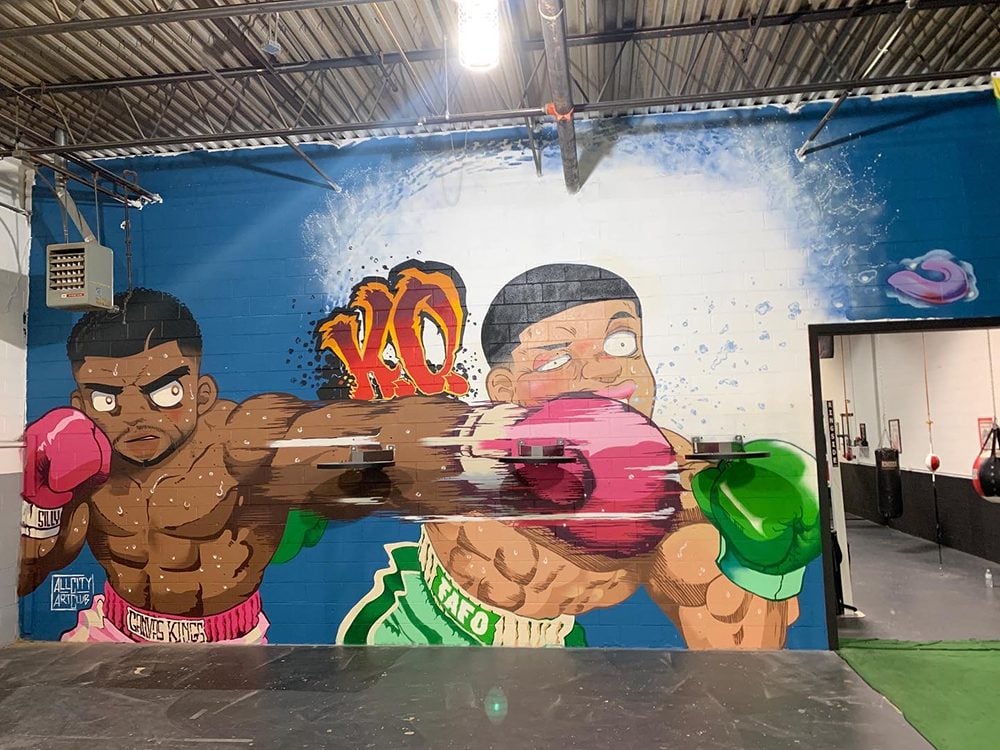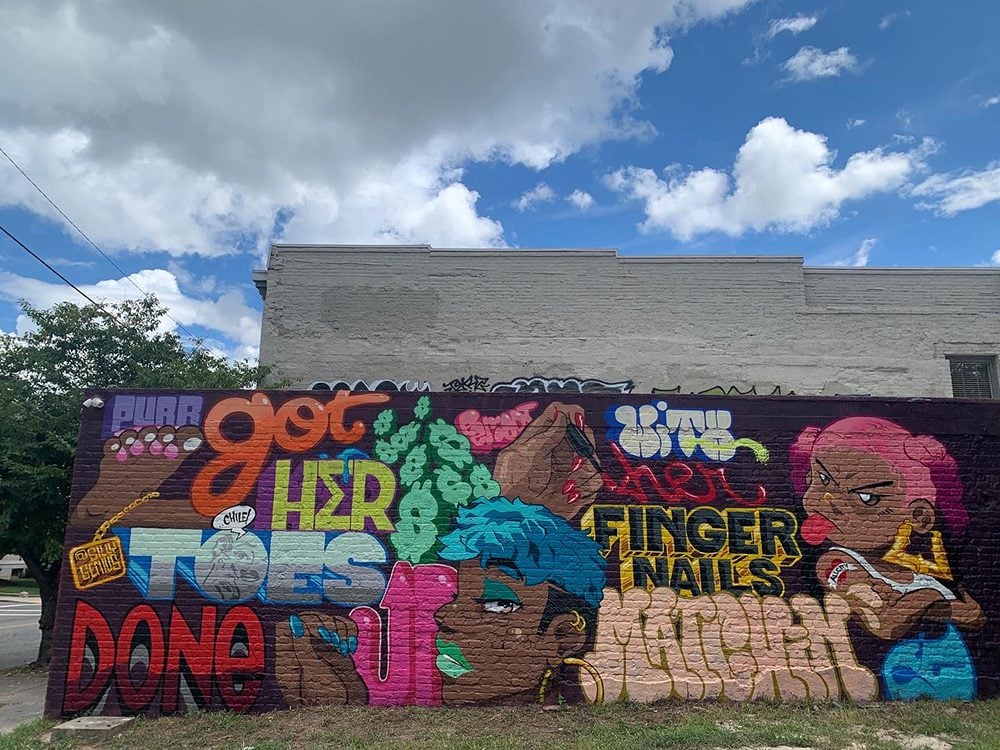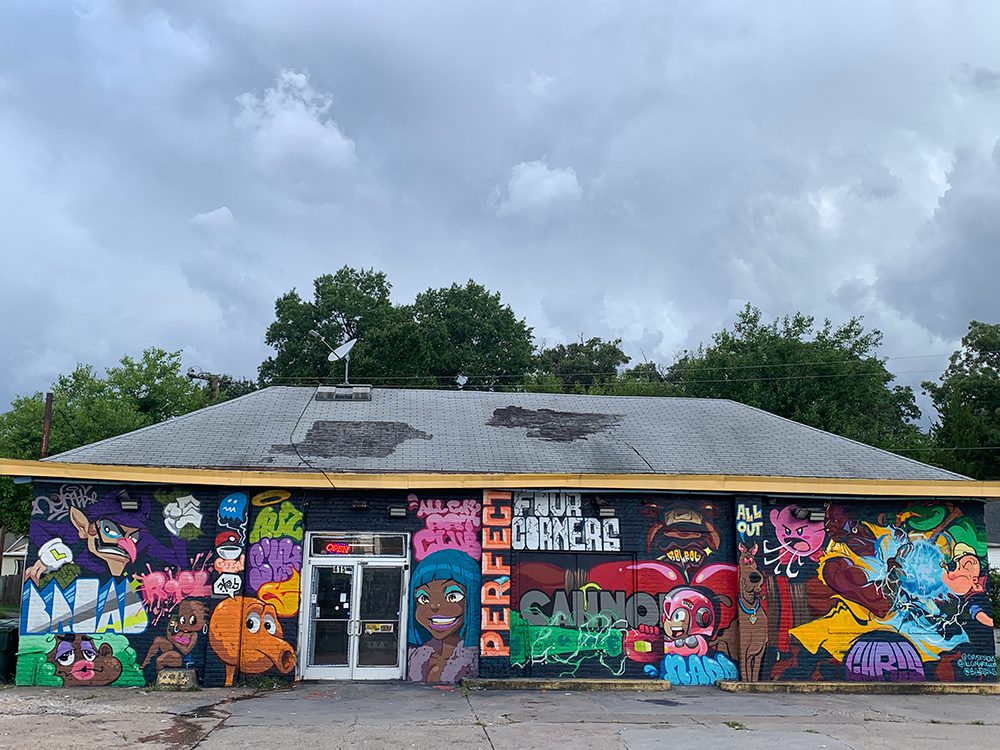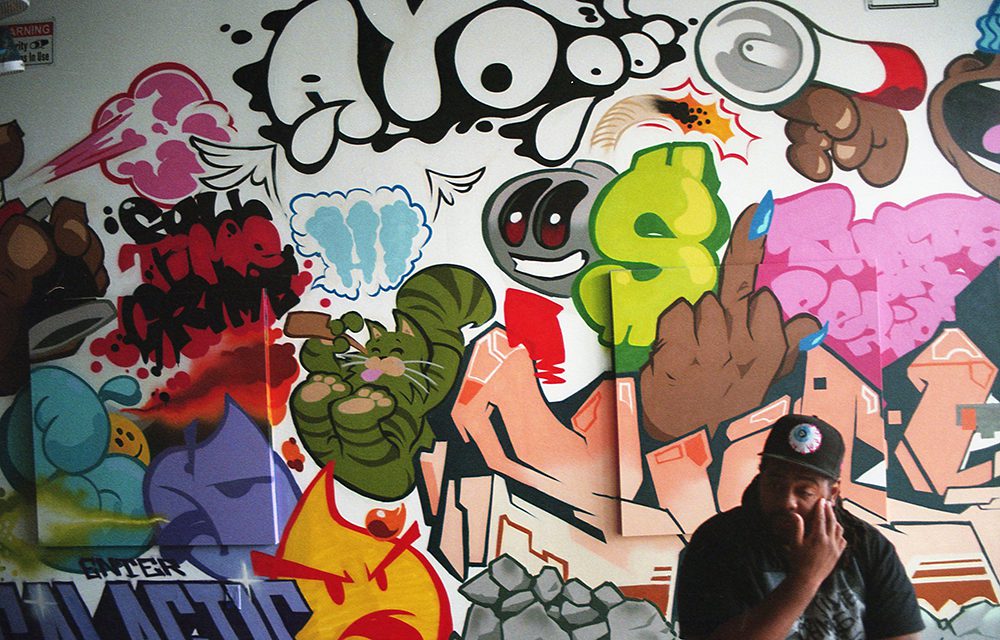Street art has the power to not only beautify a neighborhood but also to bring people together and create a sense of community. Silly Genius, a visual artist known for their street art, graffiti, and mural work, understands the impact that art can have on a community. In this interview, we dive into Silly Genius’s experience as a community organizer and how he uses his art as a tool for activism. We also explore the socio-political aspect of art in Richmond, particularly the gentrification of neighborhoods and the importance of representation in art.
ed. note: If anyone has a space that could be a gallery in Manchester, give Silly Genius a shout!
Who are you and what do you do?
My name is Silly Genius and I am a visual artist. I do a bunch of different things, but most people know me for my street art, graffiti, and mural work.
Do you also do graphic design and photography?
Yes, I dabble in graphic design and photography as well as illustration.

Image courtesy of Silly Genius
Would it be fair to say that you are a community organizer? It seems like you bring a lot of people together.
I view activism as a puzzle, and everyone plays a different role in it. For me, art is my tool or vehicle, and I use it to influence, engage, and inspire people. I try to use it to further the missions of other activists around me. They are the people who actually try to make structural change, but I use my art to help them too.
Does that come naturally?
Yeah, it was by chance. I wouldn’t have gotten to this position if it wasn’t for the first mural festival, which you played a part in. There was this period when they were looking for more walls, and I would suggest walls like on the south side or wherever, but they wanted to stay in a specific area. I took offense to it, you know, like there’s so many walls, there’s so much more opportunity. If people want to see the art, they will take the drive over here. And I just took it upon myself.
And then within that, as somebody who was facilitating all that, just the process of trying to find walls and space and the hurdles you come into, and then like, you start to see the socio-political layers of it, like who gets to do what and when, and how, and the shot callers and all that stuff. So I just kind of almost by osmosis fell into the idea of activism.

Image courtesy of Silly Genius
Yeah, I think you touch on something that’s probably very frustrating. My role in the original Richmond Mural Project idea was to bring it to town and raise funds but I found out all the funding was contingent on all the art essentially being centered in downtown. Manchester wasn’t a place back in 2013 that was being invested in.
Now, 10 years later you can see it, Manchester is developing and further up Hull Street is starting to trickle up the street. You are starting to see a real community with Manchester Manifest and businesses starting to set down roots. But as soon as you start putting murals up and getting organized around an identity, the developers come in and buy it up. So then it just pushes the artists back out. Is that a frustrating thing to kind of see? Do you feel like that?
Yeah, because it’s like, for me, you don’t have to push people out to improve a place. Like if you want to build new buildings, you can build new buildings, but why do we need the people that already lived there to leave to do so? And it’s come to, you know, I’m just painting, so like, how much can I really do other than amplify the voices of the people that are fighting that specific battle and being more intentional about the representation within the art. This is a historically Black neighborhood. So let me paint things that signify that. So that when new people come into those communities, they kind of know where they are, versus just putting miscellaneous imagery. People just kind of move in and take over.
Imagery that doesn’t actually represent the neighborhood.
Yeah, you know, like that was like a critique of the Richmond Mural Festival in the beginning, because it didn’t necessarily have any identity that you could link back to Richmond. And it’s like no fault of the artists, they’re not from here. So they’re just doing their thing. But being someone who’s living here, knowing what’s happening, what’s going on, you can kind of tap into that and make it feel more connected to it and make people take ownership over it.
That’s another interesting thing that gets lost out in the public, because the idea for me behind the Richmond Mural Project was to spark murals as a thing in the first place, street art wasn’t a thing in the city back in 2011. There were literally a couple of muralists in the entire city at that time. You’re right, the art wasn’t directly connected to the city, but it had to start somewhere. But now the local artists have taken the idea and it’s become more organic and more about the neighborhoods, and that’s nice to see.
Maybe you have some thoughts on this, but I’m seeing more black representation, not only in the murals, but I feel like in the general art scene in Richmond. Do you feel like that’s happening?
The internet is playing a big part in that. It’s a little bit more leveling of the playing field, access to the public, materials and supplies. And you don’t have to go through anyone. I mean, it’s still a battle with the galleries and all that, but as far as the streets and just kind of doing your own thing, there’s definitely an uptick in Black representation and participation. And, like, rightfully so, you look at the demographics of the city, it’s majority Black, even just by a small fraction. But on the surface, you wouldn’t think that. But you go look at the census, it’s like more than 50% Black.

Image courtesy of Silly Genius
Now where are the voices in how they get empowered? I mean, that’s really kind of a new thing, probably in the last three or four years. Right before 2020, I felt like there were some inroads, and people were getting better representation and opportunity. So let’s talk about your work for a second. What inspires you, your work, and your style?
I mean, mostly the stuff I grew up on. Like a latchkey kid, you know, I spent an ungodly amount of hours in front of TV, watching cartoons, reading comic books, watching music videos, and all that stuff kind of filtered into my work. And then graffiti, I was introduced to that, like super early. And then you factor in just life experiences and what’s happening socially and all that and you just throw it all in the pot. The art that I make is what comes out.
Are you seeing opportunities for graffiti writers to make a living or is it still kind of like, you just have to do it underground?
Yes, it’s still kind of on the underground. Like, there’s still this negative connotation of graffiti. People just don’t see the artistic merit of it. And it’s such a weird thing for me, as like an artistic, creative person who just enjoys the vastness of art. Like, people love signs, but don’t like graffiti. And I’m like, “how are you not even connecting the dots?” And, I mean, it’s just a hair away from that. So yeah, you kind of have to play that game of like, leaving some of the graffiti aesthetics behind to get your foot in the door, so people can pay attention to what you’re trying to do, and then circle back around to the graffiti once they’ve latched on.

Image courtesy of Silly Genius
Yeah, give them something they can recognize, or maybe “safe” is the right word. You kind of have to decipher graffiti.
It is very much like an inside joke. If you’re a writer, you can recognize it.
I saw your post about your show in February. And I think you’re correct. You know, Richmond is such a small city and in trying to become a professional artist, there is a lot of gatekeeping in town. Would you like to speak on that? Also, I am not trying to put you in a spot. We can change the subject if you want.
No, it’s not that — there’s the black and white way to look at it. And then there’s the nuance. The galleries have to make money. They have to cater to the people that are buying the art. So, if the people with the money like landscapes, then I gotta sell landscapes and it’s hard to introduce this wild, unconventional thing of contemporary street art.
But on the other hand, just look at the rest of the world, you know. You just came from New York, like graffiti is in the DNA of that city. So there’s nothing for a graffiti writer to become the level of whatever else, like Miami with Art Basel, or Chicago or LA. Like all these places, we all have access to that now. You can just look at it on your phone and see what the rest of the world is doing.
And then you come back to Richmond, who is like, this close to being on a level where we could very easily be in the conversation of a Chicago or Detroit or, or Miami, but they just won’t take that step into like, the “New” or what art is current. Even with the street art scene? That’s very much what is the pulse of the culture right now. But then you step into a Richmond gallery, and it’s like, the same old thing.
Yeah, I mean, I was talking to some other artists, and I can’t stand it. It’s either landscape or like paintings of animals. And I mean not like paintings of animals is bad, but I’m just saying that a lot of it feels like wallpaper, you know, just kind of like background stuff. Are you saying that maybe it would be nice if one of the few galleries in town, which there aren’t many, took a chance and was like, we’re gonna have a street art show, see what’s up?
It doesn’t even necessarily have to be like that, just introduce artists from the street art world into the gallery like you would the most amazing landscape painter. But if the whole gallery is built on landscapes, it’s just run of the mill. You got to place the art beside something else so you can see the difference, like, “oh, that’s the technique.” Like, if you walk into the VMFA, you see a Warhol beside something completely different, okay, that I can see, there’s something different to contrast to.
But if every painting is the same thing, then what’s special about any of them? I use the VMFA for example, look at the last, let’s say, the last five years. The most popular exhibits were like Kehinde. Yves Saint Laurent. Like the movie costume exhibit, Dirty South, like all these things are not fine art, but like new urban contemporary. So it’s like, how do you see that then turn around to “We can’t do that in Richmond. This other stuff is a little too much.”
I think in their mind that there isn’t the concentration of buyers yet for it here. But again, you don’t know because no one is trying something new.
Yeah. So you gotta court that audience. They gotta show them the thing. It’s like how do you attract the young and hip whatever, but you don’t want to do young hip things?
That brings up another question. At some point, do you want to have a gallery?
I’m actually in the search for that now, as far as space. I’ve been doing this long enough that I’ve kind of gotten tired of the constant battle. And now it’s “I’ll show you what I’m trying to do. I’ll show you the idea. And you can see for yourself.” There is an audience for this thing. We know it’s there.
The irony will be that you’ll be a gatekeeper. And that happens but maybe you are the one who changes things.
I’m aware that we all kind of become it. But I have enough people around me, and I always have an ear to the street. But I would hope that I would not become the old ‘get-off-my-lawn’ guy.
I hope you understand, I wasn’t implying you would be. Somebody needs to take the step of having a space and helping the next generation get represented, right? Do you think you’d want to be on Broad Street, or it doesn’t matter?
Ideally, I would want to be in the Southside, just because Broad Street has its own kind of identity, and has had it for some time now. Whereas Southside, it’s kind of wide open. Why is so much of our arts culture concentrated in this one space? When we artists live everywhere. So why are we only coming to this one specific place to display and make whatever, when you can just do it everywhere we are?

Image courtesy of Silly Genius
I hope you find a space over there. Manchester has come a long way in the last two, three years. What positive things do you see over there, just for people that are reading this that have never even been over there?
I mean, it’s like the same thing you find everywhere else. It just didn’t really exist yet. You know what I mean, it’s just, you kind of have to go support it so they can continue and grow into something, you know. Sometimes people will complain about something not existing, but then not support it when it shows up, because it isn’t like the old thing. Like, “it’s no more clubs”, and then somebody opens them up. But it ain’t as good as the old one, but you gotta let it get it to that level. It just, it just got here. [laughs] The same thing, like this community is like, just kind of like getting its legs and it’s gonna be a while before it becomes the Cary Street or Scott’s Addition. You got to let it grow up.
So you’re saying that you want to be there when it does?
Yeah, be part of that process. Yeah. Because I think the problem is that artists don’t control anything. Like this, there’s always another layer of people who aren’t necessarily artists themselves involved in art, that just kind of like pulling the strings to benefit themselves. But the artists themselves rarely ever control anything. We suffer for that in the long run.
Well, because in this town it feels like the only people that can pay for art like murals or buy art are the developers. It is the money people defining the art most of the time. So it’s kind of like all the money is concentrated and we need to get local, everyday people that have middle-class jobs to go and buy local art. Go find some artists to support.
Last thing, do you have any goals for yourself? What do you hope to see for this year?
Besides the space, just more of what I’ve already been doing, but on a grander scale. I feel like I’m doing a lot, but I’m not doing enough. I want to be more impactful and have more freedom in my creative endeavors. I don’t feel like I’ve hit my peak yet, and I’m still kind of playing the game. But I want complete creative control and to finally do the things I’ve been talking about for so long.

Image courtesy of Silly Genius
And I feel like, to help others get up too. That’s dope. I really appreciate you coming by. That’s all the questions I had. Do you have anything you want me to add?
Not really, just support the art. It’s like, imagine your life without your favorite TV shows or music or fashion. There’s an artist making those things, and if you want to keep enjoying them, you have to support the arts, even in a small way.
For more information on Silly Genius: silly-genius.com
Follow Silly Genius: @sillygenius



